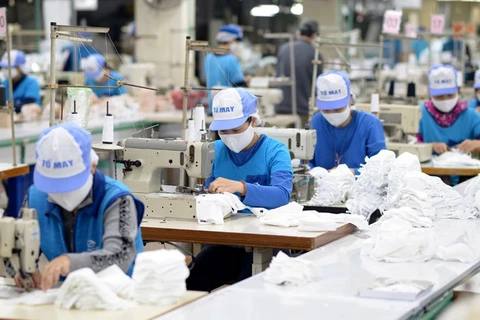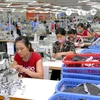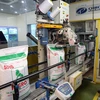 Textile and garment enterprises optimise production and management to increase product competitiveness. (Photo: ViethnamPlus)
Textile and garment enterprises optimise production and management to increase product competitiveness. (Photo: ViethnamPlus) Hanoi (VNA) – Garment and textile companies have been struggling to overcome prolonged difficulties due to the decline in demand in their main textile import markets, according to the Vietnam National Textile and Garment Group (Vinatex).
In the first nine months of this year, the textile and garment export turnover reached 25.5 billion USD, down 12.1% over the same period last year.
According to Vinatex, enterprises suffer from an increase in input costs. These include an increase of 3% in energy and electricity prices from May, and a 3% increase in exchange rates since the end of the second quarter. At the same time, they also face fierce competition in terms of price from rival countries.
This situation means businesses face a host of challenges in terms of market, finance, and production. Export orders have decreased in quantity, are highly demanding, have short-term order plans, and an extension of delivery time, hurting production and business results in 2023.
Le Mac Thuan, deputy general director of Vinatex, said that enterprises in the domestic garment industry in 2023 are impacted by the decline in global demand.
However, businesses with customers in the US market will recover faster, while the European market still has difficulty, Thuan said.
Than Duc Viet, general director of Garment 10 Corporation, said his enterprise's advantage is shirts, but in 2023, the export of this item suffered the most damage.
According to him, shirts accounted for 60% of Garment 10's export volume in previous years, but now it only accounts for 39%. The business has to receive orders of pants, polo shirts, and T-shirts.
So, to achieve the targets, businesses in the textile and garment industry are required to seize opportunities to enhance production and business in the last quarter. That would also create momentum for production and business plans in 2024.
Regarding the fibre industry, Tran Huu Phong, chairman of Vinatex Phu Hung JSC, said in the last months of 2023, the fibre industry will not improve. Businesses face multiple challenges, including the high cost of inputs from increasing electricity prices to high interest rates and high raw material prices.
“Currently, the price of Phu Hung's cotton inventory is relatively high as we have to import raw materials at high prices. When the market changes quickly, customers still cancel orders even though the deals have been signed. Phu Hung had to reduce prices a lot,” Phong shared.
Assessing Vietnam's textile and garment export market, the representative from Vinatex said that exports peaked at 4.06 billion USD in August and decreased in September. However, exports to the US and China markets increased by 2% and 11% respectively over the same period.
Specifically, for the garment industry, in the fourth quarter of 2023, the majority of Vinatex's affiliated businesses have fewer orders than usual but there are signs of more discussions on orders from customers.
The question now for the textile and garment enterprises is marketing work and labour productivity.
As for the fibre industry, the price of cotton in the third and fourth quarter of 2023 is currently approaching the market price and is lower than the price the first six months of the year.
Meanwhile, Tran Thi Kim Chi, general director of Phu Bai Fiber JSC, said that fibre production in the coming time must be calculated carefully. Excessive raw material inventory and a high price of input material put a lot of pressure on the yarn production businesses.
Phu Bai is also greatly affected by exchange rates and reduced profits, but it realizes the need to continue to produce high-quality yarn, reduce costs, and select quality customers. The company follows the market closely to increase the production of products that the market needs, Chi said.
According to businesses, 2024 will be a year of great competition in price. Furthermore, customers will have few orders but require fast delivery, high product complexity, diversification of designs, and strict quality.
Along with that, customers are very interested in product quality and choose businesses to sign long-term cooperation agreements.
Nguyen Xuan Duong, chairman of Hung Yen Garment Corporation, said
businesses need to invest in automation, improve the capacity of workers, and reduce the cost of capital management./.


























